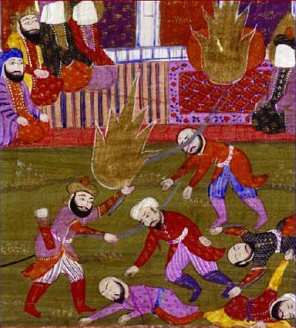|
Jews In Saudi Arabia
The history of the Jews in the territory of modern Saudi Arabia begins in Biblical times, at least as early as the First Temple period. Some have estimated that there are about 3,000 Jews currently residing in the country. Early history The first mention of Jews in the areas of modern-day Saudi Arabia dates back, by some accounts, to the time of the First Temple. Immigration to the Arabian Peninsula began in earnest in the 2nd century CE, and by the 6th and 7th centuries there was a considerable Jewish population in Hejaz, mostly in and around Medina. This was in part due to the embrace of Judaism by such leaders as Dhu Nuwas; who was very aggressive about converting his subjects to Judaism. Nuwas persecuted Christians in his kingdom as a reaction to the Christian persecution of Jews by the local Christians and Abu Karib Asad. In 523, the Himyarite king Dhu Nuwas (Dunaan), who had converted to Judaism, massacred the Christians there. According to Al-Masudi the northern par ... [...More Info...] [...Related Items...] OR: [Wikipedia] [Google] [Baidu] |
Saudi Arabia Map , the ruling family of Saudi Arabia
{{disambiguation ...
Saudi may refer to: * Saudi Arabia * Saudis, people from Saudi Arabia * Saudi culture, the culture of Saudi Arabia * House of Saud The House of Saud ( ar, آل سُعُود, ʾĀl Suʿūd ) is the ruling royal family of Saudi Arabia. It is composed of the descendants of Muhammad bin Saud, founder of the Emirate of Diriyah, known as the First Saudi state (1727–1818), and ... [...More Info...] [...Related Items...] OR: [Wikipedia] [Google] [Baidu] |
Ferdinand Wüstenfeld
Heinrich Ferdinand Wüstenfeld (31 July 1808 – 8 February 1899) was a German orientalist, known as a literary historian of Arabic literature, born at Münden, Hanover. He studied theology and oriental languages at Göttingen and Berlin. He taught at Göttingen, becoming a professor there (1842–90). He published many important Arabic texts and valuable works on Arabic history. Writings and translations *Navavi, Liber concinnitatis nominum (1832) * (1833–34) * (1835) *Ibn Challikan, Vitae illustrium virorum (1835–50) *Geschichte der Arabischen Ärzte und Naturforscher (1840) *Navavi, ''Tahdhib al-Asma'', Biographical dictionary of illustrious men (4 bd, 1842–47) The biographical dictionary of illustrious men, chiefly at the beginning of Islamism; now first ed. from the collation of two mss. at Göttingen and Leiden (1842)*Makrizi, Geschichte der Kopten (1846) *Zakariya al-Qazwini, ‘Aja'ib al-makhluqat, Zakarija Ben Muhammed Ben Mahmud el-Cazwini's Kosmographie (2 v ... [...More Info...] [...Related Items...] OR: [Wikipedia] [Google] [Baidu] |
Banu Shutayba
The Banu Shutayba was one of the Jewish tribes of Arabia during Muhammad's era. They were included in point 31 of the Constitution of Medina as allies to the Muslims, being as "one nation", but retaining their Jewish religion Judaism ( he, ''Yahăḏūṯ'') is an Abrahamic, monotheistic, and ethnic religion comprising the collective religious, cultural, and legal tradition and civilization of the Jewish people. It has its roots as an organized religion in the M .... References {{DEFAULTSORT:Shutayba Jewish tribes of Arabia ... [...More Info...] [...Related Items...] OR: [Wikipedia] [Google] [Baidu] |
Banu Quda'a
The Quda'a ( ar, قضاعة, translit=Quḍāʿa) were a confederation of Arab tribes, including the powerful Kalb and Tanukh, mainly concentrated throughout Syria and northwestern Arabia, from at least the 4th century CE, during Byzantine rule, through the 12th century, during the early Islamic era. Under the first caliphs of the Syria-based Umayyad Caliphate (661–750), the Quda'a occupied a privileged position in the administration and military. During the Second Muslim Civil War (683–692) they allied with South Arabian and other tribes in Syria as the Yaman faction in opposition to their rivals, the Qays confederation, in what became a rivalry for power and influence which continued well after the Umayyad era. In forging this alliance, the Quda'a's leaders genealogically realigned their descent to the South Arabian Himyar, discarding their north Arabian ancestor, Ma'add, a move which elicited centuries-long debate and controversy among early Islamic scholars. Genealogical ... [...More Info...] [...Related Items...] OR: [Wikipedia] [Google] [Baidu] |
Banu Jusham
) , type = Adnanite/Qaysi Arab tribe/Ishmaelites , image = , image_size = , alt = , caption = , nisba = , location = , descended = Jusham ibn Sa'd ibn Bakr ibn Hawazin ibn Mansur ibn Ikrimah ibn Khasafah ibn Qays ʿAylān ibn Mudar ibn Nizar ibn Ma'add ibn Adnan. , parent_tribe = Hawazin , branches = *Banu Uday *Banu Ghazia *Bani Asima *Bani Amer *Bani Eshan , religion = Polytheism (pre-630s) Islam (post 630s) The Banu Jusham ( ar, بنو جشم) were a large sub-tribe in the Arabian Peninsula during the time of Mohammed. According to genealogists and various oral traditions, they are the descendants of Jusham ibn Sa'd ibn Bakr ibn Hawazin. Branches The main tribes that constituted this sub-tribe were as follows: Banu Ghazia invading And the Gazans are an independent tribe, their largest and their homes were with their people in Sarawat between Tihama and Najd, and after Islam, it spread in Iraq and the Magh ... [...More Info...] [...Related Items...] OR: [Wikipedia] [Google] [Baidu] |
Banu Harith
The Banu al-Harith ( ar, بَنُو الْحَارِث ' or ar, بَنُو الْحُرَيْث ') is an Arabian tribe which once governed the cities of Najran, Taif, and Bisha, now located in southern Saudi Arabia. History Origins and early history The Banu Harith descend from the Qahtanite people, one of the most prominent Arab tribes originating from Yemen. The earliest recorded ancestor of the Qahtanites is Joktan, one of the two sons of Eber. The Qahtanite people are divided into the two factions, the Himyarite and Kahlani tribes. The Kahlani tribe can be further broken into smaller sub-groups which include the Banu Harith which was established by Harith bin Ka'b. Originally published: London : Edward Arnold, 1892 The Banu Harith converted to Judaism during pre-Islamic times.Charles Kurzman, ''Liberal Islam'', p. 172Norman Stillman, ''The Jews of Arab Lands: A History and Source Book'', p. 117 They wore a jambiya on their belt and worked primarily in goldsmithing and repair ... [...More Info...] [...Related Items...] OR: [Wikipedia] [Google] [Baidu] |
Banu Awf
The Banu Awf ( ar, بنو عوف, ) was one of the Jewish tribes of Arabia during Muhammad's era. The Banu Awf was an Arab tribe who wished to settle in the Jewish-ruled Tayma. The local people in Tayma insisted as a condition of settling in Tayma, Banu Awf must adopt Judaism. After having done so, they moved on to Yathrib. They were included in Point 25 of the Constitution of Medina as allies to the Muslims, being as "one nation", but retaining their Jewish religion Judaism ( he, ''Yahăḏūṯ'') is an Abrahamic, monotheistic, and ethnic religion comprising the collective religious, cultural, and legal tradition and civilization of the Jewish people. It has its roots as an organized religion in the M .... References [...More Info...] [...Related Items...] OR: [Wikipedia] [Google] [Baidu] |
Banu Alfageer
The Banu Alfageer was one of the Jewish tribes of Arabia during Muhammad's era. They were included in point 31 of the Constitution of Medina as allies to the Muslims, being as "one nation", but retaining their Jewish religion Judaism ( he, ''Yahăḏūṯ'') is an Abrahamic, monotheistic, and ethnic religion comprising the collective religious, cultural, and legal tradition and civilization of the Jewish people. It has its roots as an organized religion in the M .... References Jewish tribes of Arabia {{Saudi-stub ... [...More Info...] [...Related Items...] OR: [Wikipedia] [Google] [Baidu] |
Invasion Of Banu Qurayza
The Invasion of Banu Qurayza took place in Dhul Qa‘dah during January of CE 627 ( AH 5) and followed on from the Battle of the Trench (Muir, 1861). The Banu Qurayza initially told the Muslims that they were allied to them during the Battle of the Trench, however, later they sided with the Pagan Arabs of Quraysh and their allies.. According to traditional sources, Jewish leaders organized efforts against Muhammad and the Muslims. Three Jewish leaders from the tribe of Banu al-Nadir, three Jewish leaders from the tribe of Wa'il, and various other Jewish groups and leaders united and pressured Banu Qurayza to betray their agreement to Muhammad. Afzalur Rahman states that during the Battle of the Trench, when the Muslims were surrounded by a large hostile force, the Banu Qurayza joined the enemies of the Muslims and threatened the Muslims from within the town itself. Waqidi claims that Muhammad had a treaty with the tribe which was torn apart. Norman Stillman and Watt believe su ... [...More Info...] [...Related Items...] OR: [Wikipedia] [Google] [Baidu] |
Muhammad
Muhammad ( ar, مُحَمَّد; 570 – 8 June 632 Common Era, CE) was an Arab religious, social, and political leader and the founder of Islam. According to Muhammad in Islam, Islamic doctrine, he was a prophet Divine inspiration, divinely inspired to preach and confirm the tawhid, monotheistic teachings of Adam in Islam, Adam, Abraham in Islam, Abraham, Moses in Islam, Moses, Jesus in Islam, Jesus, and other Prophets and messengers in Islam, prophets. He is believed to be the Seal of the Prophets within Islam. Muhammad united Arabian Peninsula, Arabia into a single Muslim polity, with the Quran as well as his teachings and practices forming the basis of Islamic religious belief. Muhammad was born approximately 570CE in Mecca. He was the son of Abdullah ibn Abd al-Muttalib and Amina bint Wahb. His father Abdullah was the son of Quraysh tribal leader Abd al-Muttalib ibn Hashim, and he died a few months before Muhammad's birth. His mother Amina died when he was six, lea ... [...More Info...] [...Related Items...] OR: [Wikipedia] [Google] [Baidu] |
Banu Qurayza
The Banu Qurayza ( ar, بنو قريظة, he, בני קוריט'ה; alternate spellings include Quraiza, Qurayzah, Quraytha, and the archaic Koreiza) were a Jewish tribe which lived in northern Arabia, at the oasis of Yathrib (now known as Medina). Jewish tribes reportedly arrived in Hijaz in the wake of the Jewish-Roman wars and introduced agriculture, putting them in a culturally, economically and politically dominant position.Peters, ''Muhammad and the Origins of Islam'', p. 192f. However, in the 5th century, the Banu Aws and the Banu Khazraj, two Arab tribes that had arrived from Yemen, gained dominance. When these two tribes became embroiled in conflict with each other, the Jewish tribes, now clients or allies of the Arabs, fought on different sides, the Qurayza siding with the Aws.Watt, "Muhammad", In: The Cambridge History of Islam, Vol. 1A, pp. 39-49 In 622, the Islamic prophet Muhammad arrived at Yathrib from Mecca and reportedly established a pact between the co ... [...More Info...] [...Related Items...] OR: [Wikipedia] [Google] [Baidu] |
Banu Qainuqa
The Banu Qaynuqa ( ar, بنو قينقاع; he, בני קינוקאע; also spelled Banu Kainuka, Banu Kaynuka, Banu Qainuqa, Banu Qaynuqa) was one of the three main Jewish tribes living in the 7th century of Medina, now in Saudi Arabia. The great-grandfather of Banu Qaynuqa tribe is Qaynuqa ibn Amchel ibn Munshi ibn Yohanan ibn Benjamin ibn Saron ibn Naphtali ibn Hayy ibn Musa and they are descendant of Manasseh ibn Yusuf ibn Yaqub ibn Ishaq son of Ibrahim. In 624, they were expelled during the Invasion of Banu Qaynuqa, after breaking the treaty known as the Constitution of Medina.Watt (1956), p. 209. Background In the 7th century, the Banu Qaynuqa were living in two fortresses in the south-western part of the city of Yathrib, now Medina, having settled there at an unknown date. Although the Banu Qaynuqa bore mostly Arabic names, they were both ethnically and religiously Jewish. They owned no land, earned their living through commerce and craftsmanship, including goldsmithery.We ... [...More Info...] [...Related Items...] OR: [Wikipedia] [Google] [Baidu] |


